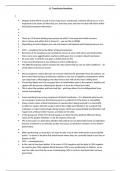Lecture notes
transfusion reactions
- Module
- Clinical science
- Institution
- Aston University, Birmingham (Aston)
preview:• Cross matching forms a key component of blood transfusion – it is ultimately what we do – we are gong to make sure the blood we give to a patient form the donor is compatible. • Many reasons when a blood transfusion is required form being involved in a road traffic accident or su...
[Show more]



